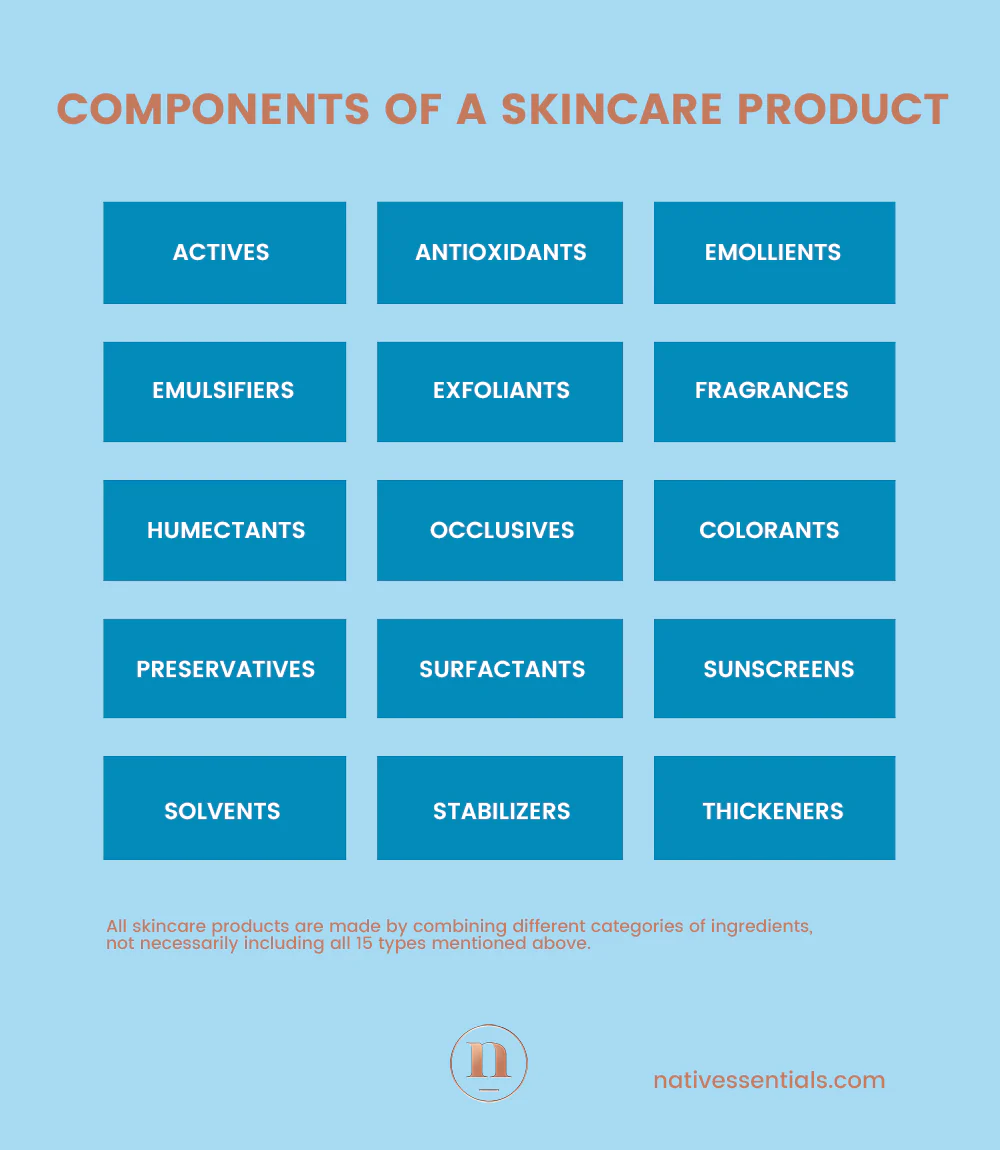
Skincare Benefits of Lactic Acid – Why is Lactic Acid Good for Skin?
We’ve been discussing facial acids for a while now, and if you’ve read our previous articles, you’ll have a better understanding of what AHAs and BHAs are and their benefits for skin. This guide focuses on lactic acid.
So what exactly is lactic acid, where is it extracted from, and how does it differ from other acids on the market? Let’s explore the benefits of using this acid and why it’s so popular with beauty experts and brands. Since it’s been used for centuries, it’s really no surprise.
We take a closer look at what lactic acid can do for your skin, and how to properly use this radiant fruit acid!
What is Lactic Acid?
Lactic acid is part of the AHA family and is obtained from natural sources like sour milk and fructose. It also occurs naturally in the body and can cause a buildup after exercise or workouts.
It also has a variety of skincare properties that other acids can’t match, such as: Similar to glycolic acid, it has a unique set of benefits that will make your skin smoother, firmer, and more flawless! Unlike other acids, lactic acid is an alpha hydroxy acid that exfoliates and acts as a humectant by drawing water into the outer layer of the skin, making your face look plumper, younger, and with visibly fewer fine lines and wrinkles.
Swedish chemist Carl Wilhelm Scheele first isolated the compound from yogurt in the late 1800s. German pharmacist Boehringer Ingelheim then figured out how to mass produce lactic acid by fermenting the sugars and starches in yogurt with bacteria. Due to its structure, lactic acid’s larger molecules don’t penetrate deeply into the skin. Instead, it works more as a surface treatment by exfoliating and tightening the skin.
Because lactic acid is considered the gentlest facial acid, it’s a great place to start if you want to introduce AHAs into your skincare routine, especially if you have a sensitive skin type.
Quick Facts
Ingredient Type
Acid/Peeling
Key Benefits of Lactic Acid
Firmer, Thicker Skin
Reduces Fine Lines and Wrinkles
Reduces Breakouts, Such as Spots
Who Should Use Lactic Acid?
Generally speaking, anyone can use lactic acid as it is beneficial for all skin types. Always consult your dermatologist if you have any concerns.
How often can you use lactic acid?
Daily use is recommended, but should be used every other day initially.
Lactic acid works well with moisturizing ingredients like hyaluronic acid.
Don’t use lactic acid
Do not use with other acids and exfoliants such as AHAs or benzoyl peroxide. Retinol should also be avoided.
What are the benefits of lactic acid for skin?
Just like its AHA brethren, lactic acid has many benefits for skin, including some unique properties:
Lactic acid kills bacteria
Lactic acid can treat and prevent bacterial skin infections. It was first discovered in a study on newborns in 1985 and has since been used on adult skin. It has been shown to achieve the same results by eliminating acne and skin irritation.
Lactic acid reduces fine lines and wrinkles
Concentrations of 5-12% were tested, and both concentrations were able to penetrate the dermis and epidermis of the skin. Skin feels firmer and thicker, with fewer fine lines and wrinkles. Understandably, the strength of the acid limits the layers of skin it can penetrate.
Lactic Acid Reduces Acne
The use of lactic acid has been shown (impressively often) to reduce the development of acne, and can also treat already visible acne. This is also why lactic acid is included in many body care lotions and moisturizers to treat blemishes on other areas such as the chest and back.
Lactic Acid Boosts Cell Turnover
Due to lactic acid’s exfoliating and moisturizing properties, the rate of skin turnover can be increased. This occurs naturally within 30 days, but can be slowed by age and other aggressors. Lactic acid also stimulates collagen production and strengthens the skin, making it firmer, plumper, and more youthful.
Lactic Acid Helps Skin Retain Moisture
This is unique to lactic acid compared to other AHAs available, and has to do with lactic acid being a humectant. Lactic acid locks in moisture, making it perfect for helping the new skin revealed after a chemical peel retain and lock in moisture.
Lactic Acid Evens Out Skin Tone
Lactic acid has significant benefits for the skin, lightening the tone of any pigmentation, such as dark spots, acne scars, and melasma. Lactic acid is considered one of the gentlest alpha hydroxy acids, which means it makes a great introduction to facial acids. It is also popular with beauty professionals when they are used in chemical peels. Due to the higher concentrates used in professional treatments, skin irritation may occur. Keep in mind that your skin may also be sensitive to the sun, so always apply adequate SPF.
Lactic Acid Shrinks Pores
The strength of the lactic acid used on the skin depends on how successful it is in helping to shrink pores. AHAs typically only work on the outer layer of the skin, but lactic acid is one of the few acids that consists of larger molecules and can penetrate deeper into the skin depending on the percentage of concentrate.
The aforementioned properties of lactic acid can help your skin look and feel its best. Combining these AHAs with other moisturizing, cleansing, and hydrating products will give your skin an overall flawless, radiant look.
How to Use Lactic Acid
Lactic acid is extremely versatile and is found in many skin and body care products:
Face cleansers
Face creams
Face serums
Masks
Hand creams
Shower gels
Body moisturizers
Perhaps you know the story of Cleopatra and her infamous milk baths? Well, the old queen was definitely on the right track when it comes to the skin-pampering benefits of lactic acid. It removes dead skin cells without affecting the pH of the skin barrier.
One thing you need to remember is that while lactic acid is gentle, it is still an acid and can cause irritation if not used correctly. Here are some simple tips about AHAs to help you get the best results when using it in your skincare routine.
It’s best to remember the phrase “three on, three off.” What I mean by that is use the acid three nights in a row, then take three nights off and use more moisturizer.
Lactic acid can be used by any skin type, but using it too often and in too large a quantity can cause inflammation, which can speed up the aging process.
If your skin is already inflamed or red, it’s best to avoid lactic acid altogether.
To get the most out of it, avoid physical exfoliants and use it after cleansing and before moisturizing to give the lactic acid enough time to restore your face’s glow.
It’s best to take professional advice. If you want to add lactic acid or are using it for the first time, talk to your dermatologist or primary care physician.
Which skin types can use lactic acid?
All skin types benefit from using lactic acid in moderation, but every skin type can run into problems if it’s used too frequently.
Dry Skin – Due to the moisturizing effects of lactic acid, over-the-counter formulas can use this AHA for dry skin without over-drying and irritating the skin. If you’re looking for a stronger product and want a professional peel, be prepared for a thorough consultation to ensure your skin isn’t damaged. Peels should be observed with caution, as recovery from peels can take several weeks.
Oily Skin – Similar to the BHA salicylic acid, lactic acid can penetrate deeper into the skin, clearing out all the residue, bacteria, excess sebum, and pollution from the pores for a clearer, flawless complexion.
Normal Skin – Using lactic acid in your daily routine can keep your skin healthy and glowing, as the acid breaks down the glue that holds dead skin cells together, making them easier to peel off.
Skin conditions like eczema, psoriasis, and rosacea can also be treated with lactic acid, usually in over-the-counter products with concentrations of 10% or less. Anything beyond this should be used by a professional.
What are the side effects of lactic acid?
Because it’s an acid, there are few side effects associated with its use. However, that doesn’t mean their use isn’t carefully considered. It can be. Here are some possible side effects of using lactic acid:
Exposure to too much sun can increase skin sensitivity. Lactic acid is a powerful exfoliant, but it can make the skin more sensitive and more susceptible to damage from the sun’s UV rays. Using the right amount of SPF every day can prevent this.
Lactic acid can cause irritation if used too frequently or before the skin has adjusted. If you follow the above recommendations, use the right amount of acid every day.
It is also recommended to do a patch test before using such a strong acid. This also applies to professional peels, as the recovery time is longer and there is the possibility of irritation to the skin, which can cause discomfort. One thing to remember is that lactic acid is the gentlest of the AHA and BHA family, it still changes the skin and must be used with all the necessary precautions.
Now that you have a better understanding of lactic acid and its many benefits for the skin. You will find it easier than ever to incorporate it into your daily skincare routine. Whether it’s uneven skin tone, aging, or acne, this amazing product will help you!
Let’s face it: if it’s good enough for the queen of ancient Egypt, it’s good enough for us!
Have you always wanted to learn more about the AHA and BHA family? Check out our guide “What are AHAs and BHAs?”


